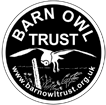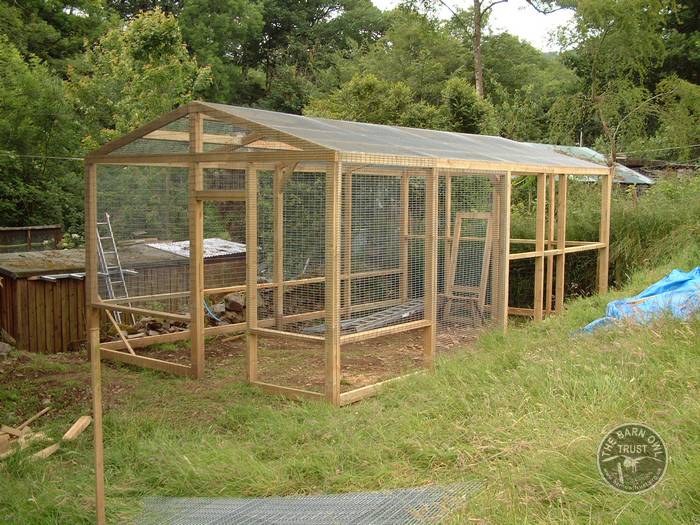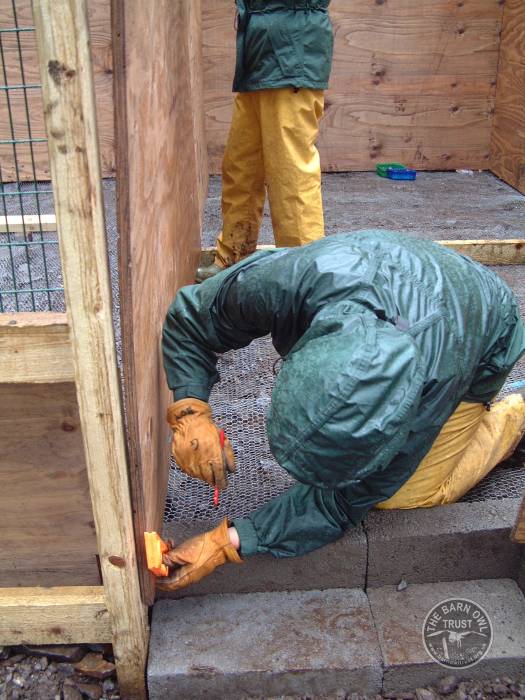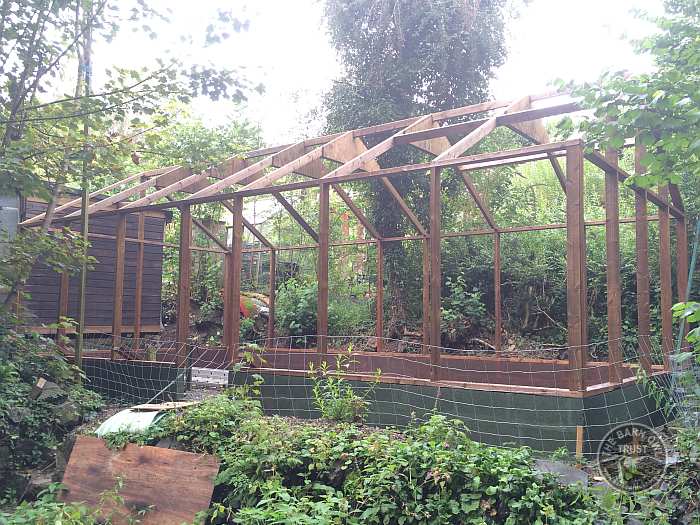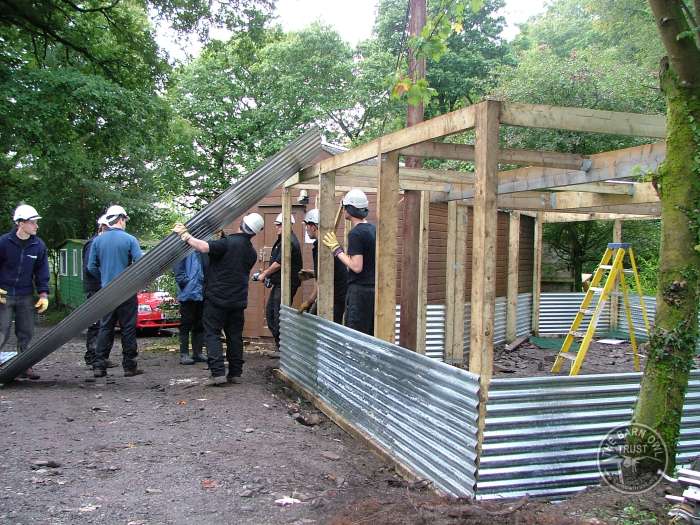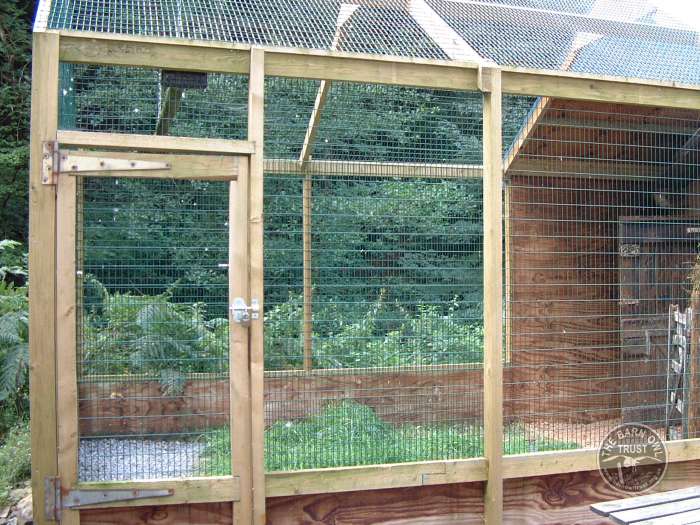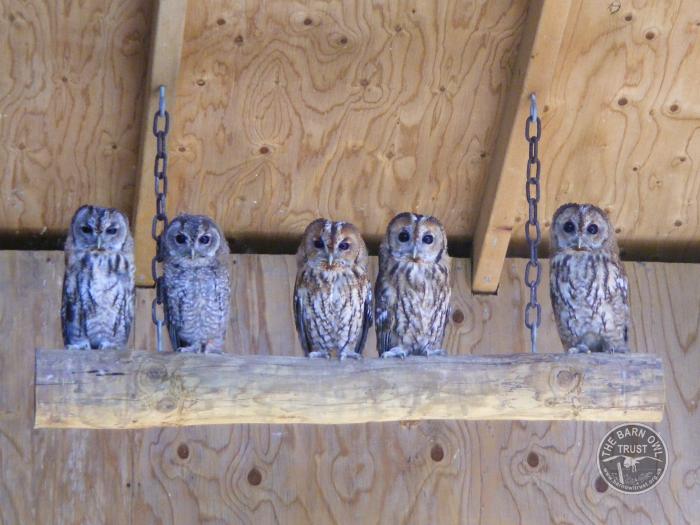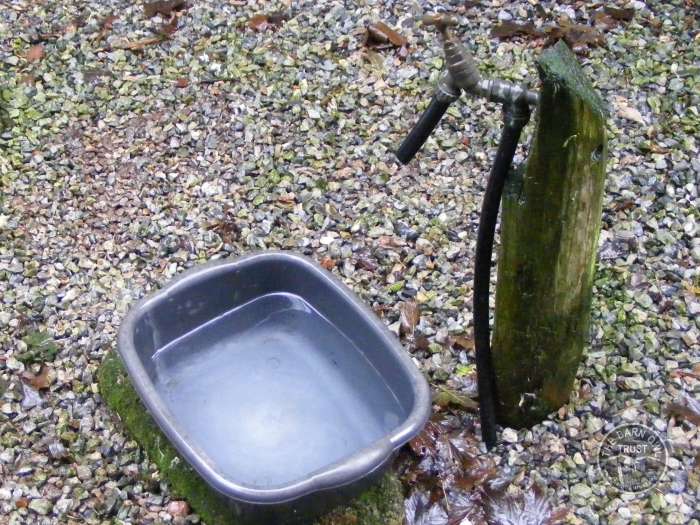Aviaries for Barn Owls
Designing and building an aviary for small to medium-sized captive owls – our recommendations
How big should an aviary be?
- The bigger the better. However, very large aviaries are a lot more expensive and make catching the birds a lot more difficult. Ideally 10-15 metres long by 4-10 metres wide.
- Capacity: the sizes provided below are based on 1 or 2 birds per aviary. The length and width should be increased by around 10% for each additional bird.
What is the minimum size?
- Length and width: not less than 7 times the bird’s wingspan long, and at least half as wide. This equates to about 6 x 3 metres for a Barn Owl.
- Height: 1.8 metres at the eaves rising to 3 metres at the apex or 2.5 – 3 metres for a flat-topped aviary.
Materials
- Frame: we use pressure-treated 100 x 50mm softwood timber which lasts about 10-15 years above ground. Locally-grown hardwood or metal are options but are generally more expensive and fixing mesh and sheet materials to them can be more difficult. Timber in contact with the ground rots relatively quickly so our new aviaries are mounted on low breeze block walls.
- Mesh type: galvanised steel mesh is best but green or black plastic-coated looks nicer. Chain-link wire and plastic mesh are not generally recommended due to the risk of entanglement and rodent damage.
- Mesh dimensions: the maximum square hole size must not exceed 50 x 50mm. The maximum rectangular hole size is 25 x 75mm. The wire thickness should be at least 1.6mm. If you can only afford wire netting, buy the thickest wire you can with a hole size of 25mm or 12mm. Barn Owls can be kept behind wire netting but a Tawny Owl must not, otherwise it will cut its cere (fleshy area above the beak).
- Wall sheets: we have previously used pressure-treated 18mm plywood or corrugated metal sheet (see photo) around the bottom of the aviary on all sides to a height of around 450mm. However, timber in contact with the ground rots relatively quickly so constructing a low breeze block wall for mounting the frame on acts as a strong wall base. Wall-sheet materials for wind/visual shelter (see below) can be the same as roof sheets.
- Roof sheets: almost any robust material can be used including treated plywood. However, there is no need to reduce light entering the aviary so transparent/translucent sheets are fine. Corrugated GRP (Glass Reinforced Plastic) is much better than cheaper plastic sheets. Beware of materials like Coroline that look substantial but can rip and will sag over time. Due to the high risk of wind damage, all corrugated/lightweight sheet materials must be fitted on top of the mesh.
- Rodent proofing: rats are attracted to owl-food and captive owls cannot be relied upon to catch any rodents that enter their aviary. Rodent-proof the aviary by laying 12mm galvanised wire netting across the aviary floor, before the final ground surface materials are brought in.
Roof design
- Shelter required: the entire roof should be covered in mesh and, for a minimum-sized aviary, a half to a third of the roof should also be covered with roof sheets. These should be on top of the mesh.
- Positioning: the portion of the roof that is covered must correspond to the position of the daytime roost perches and to a suitable ground covering beneath (see Ground designs).
Wall design
- Shelter from wind: in windy locations cover one end and half of one side to face the prevailing wind direction.
- Visual screening: parent-reared (non-tame) birds need to be able to hide. Cavity roosting species, such as Barn Owls, do not need visual screening, as long as they are provided with enclosed roost boxes. Perch or ground-roosting species, such as Short-eared Owls, must be partially screened from people etc., so they can roost in peace. Hand-reared (tame) owls do not usually need screening from people.
- Human access door: a 2-door entry system, where the entrance is effectively never open, is a good idea but is not usually required. Generally, non-tame captive owls will not get out of the door unless you leave it open and walk away. However, try to position the door so that when it is only part way open, a bird flying down the length of the aviary would have to make a very sharp turn to get out of it quickly.
Ground designs and cleaning
- Hygiene: concentrated owl droppings will kill grass, and other plants, even small shrubs. Where they accumulate on soil or dead vegetation they are smelly, unsightly and hard to remove. The droppings must either be washed away or picked up and physically removed and this determines the ground surface options.
- Concrete is by far the most permanent solution and negates the need for underground wire netting. However, there are disadvantages. Once it has been soiled, it will never look clean again. Even pressure-washing will not restore it fully.
- Gravel (e.g. a 100mm layer of 20mm ‘clean’ aggregate) is useful as, once the pellets have been picked up, the droppings can be pressure-washed and will drain down through it. It can also be raked. However, gravel eventually becomes fully-clogged and needs to be replaced. Only use gravel in areas where rain helps to keep it clean. Don’t use it below perches underneath the shelter.
- Chipped bark or sand: these are best used underneath the shelter and underneath perching places. Cleaning, especially below the perches, involves shoveling off the top layer and raking over, and adding new (clean) material.
- Turf should only be placed where rain falls and there are no perches above.
- Shrubs look nice but they take up valuable airspace and, if perched on, they become heavily soiled, unsightly and unhealthy.
- Breeding control: it is important and sometimes difficult to prevent captive Barn Owls from breeding. Keeping the ground clear is a major part of the strategy; do not give them anywhere to hide on the floor. Do not provide anything that the owls can get behind or under and make sure all sheltered corners are clearly visible to you at all times.
Interior details
- Roosting places: perch-roosting birds (e.g. Tawny, Long-eared and Short-eared Owls) need an elevated perch at the back of the sheltered end of the aviary. The required screening depends on what the visible surroundings are used for. Cavity-roosting birds (e.g. Barn and Little Owls) should be provided with roosting boxes, normally at the back of the shelter.
- Perches: a variety of branches or treated timber poles and posts of varying thicknesses should be provided, but not above any plants or soil. These can be suspended on chains. Avoid connecting perches to the wall-mesh as these nearly always cause broken feathers. Ideally, keep all perches at least a wing’s length from the mesh. 1 or 2 large rocks may help prevent overgrown talons. A coarse, mineralised bitumen roofing felt, applied to a perch or the top of a roost box can achieve the same thing. Be aware that if all surfaces, or even just the main perch is covered with this material, talons may become too worn. This will be particularly problematic if the bird is going to be released into the wild.
- Feeding place: this needs to be off the ground and easy to clean. We use wall-mounted shelves fashioned from thick aluminium and free standing timber ‘tables’ covered in thin aluminium for ease of cleaning.
- Bathing: a large bowl should be provided, half-filled with water (less for a Little Owl). If possible, install a water supply inside the aviary.
Rehabilitation and release aviary?
- The aviary described above is suitable for wild owls in the later stages of recovering from injuries, provided that they can fly.
- It can also be equipped with an opening roof and, provided that the surrounding area is suitable, it can be used for releasing owls that do not have an established territory or home range.
- Read more about owl release methods.
Adaptations for non-flying owls
Aviary design requirements are basically the same except:
- An aviary that is about 50% of the minimum size discussed above, is suitable for a disabled, flightless owl.
- A wide variety of long perches must be provided that allow the owls to climb from the ground to the food shelf/table, access all the roosting boxes/places, and use as much of the rest of the aviary-space as possible.
